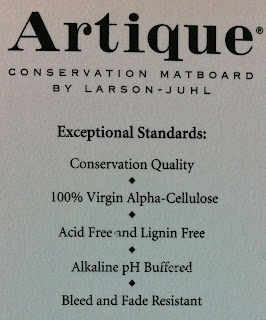 |
| Acidic mat boards showing their true colours. |
This image has three mat board layers. The middle bevel is still white and crisp, while the layers above and below it have both turned yellow with time. This is a quick indication that the middle mat board is Acid Free, while the other two are not. When these mats are removed from the image, the paper underneath will vary in colour from where the mat has been in contact and where it has not.
 |
| Alpharag - 100% Cotton Mat Board from Bainbridge |
1. 100% Cotton
The mat board of the highest conservation value is made of 100% cotton. Cotton is naturally acid free and provides the best protection over time. (The Egyptians used cotton for preservation.) Cotton mats are generally more expensive than other acid free mat boards and are limited in colour to a few shades of white, but will provide the greatest longevity for your images.
 |
| 100% Cotton Core with Buffered Surface Paper from Crescent. |
Because 100% Cotton mat boards have a very limited colour selection, buffered mats are a great option for adding colour to your framing without compromising on conservation standards. Buffering wood pulp is the most common method of creating acid free board. These boards, however, are not created equal. The highest conservation value in a dyed mat board contains a cotton core and a buffered surface paper. This allows a dyed paper to be visible and complement the image, while retaining a high conservation material as the contact layer. This type of mat board is perfect for protecting high value items, such a limited edition prints, or original artwork, while still allowing your style to show through with your colour choices.
3. Buffered Cellulose Core
 |
| Artique: Buffered Cellulose from Larson Juhl |
This post by: Megan
Edit: Originally Posted on September 10, 2013


No comments:
Post a Comment